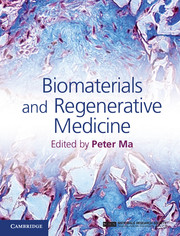Book contents
- Frontmatter
- Contents
- List of contributors
- Preface
- Part I Introduction to stem cells and regenerative medicine
- Part II Porous scaffolds for regenerative medicine
- 7 Nanofibrous polymer scaffolds with designed pore structure for regeneration
- 8 Electrospun micro/nanofibrous scaffolds
- 9 Biological scaffolds for regenerative medicine
- 10 Bioceramic scaffolds
- 11 Collagen-based tissue repair composite
- 12 Polymer/ceramic composite scaffolds for tissue regeneration
- 13 Computer-aided tissue engineering for modeling and fabrication of three-dimensional tissue scaffolds
- Part III Hydrogel scaffolds for regenerative medicine
- Part IV Biological factor delivery
- Part V Animal models and clinical applications
- Index
- References
10 - Bioceramic scaffolds
from Part II - Porous scaffolds for regenerative medicine
Published online by Cambridge University Press: 05 February 2015
- Frontmatter
- Contents
- List of contributors
- Preface
- Part I Introduction to stem cells and regenerative medicine
- Part II Porous scaffolds for regenerative medicine
- 7 Nanofibrous polymer scaffolds with designed pore structure for regeneration
- 8 Electrospun micro/nanofibrous scaffolds
- 9 Biological scaffolds for regenerative medicine
- 10 Bioceramic scaffolds
- 11 Collagen-based tissue repair composite
- 12 Polymer/ceramic composite scaffolds for tissue regeneration
- 13 Computer-aided tissue engineering for modeling and fabrication of three-dimensional tissue scaffolds
- Part III Hydrogel scaffolds for regenerative medicine
- Part IV Biological factor delivery
- Part V Animal models and clinical applications
- Index
- References
Summary
Introduction
Global demand for bone grafts has been increasing rapidly in recent years. In particular, an increase in the elderly population worldwide at an annual rate of more than 5% has led to a rapid increase in the bone-diseased population because the elderly suffer easily from osteoporotic fractures, degenerative scoliosis, and degenerative spondylolisthesis [1].
Bone is a complex biomineralized organ with an intricate hierarchical microstructure assembled through the deposition of apatite minerals on collagenous matrix [2], and is able to self-heal a small defect. However, the self-healing is less effective for a large defect. For this, bone grafting is required in orthopaedic surgery.
Bone grafting is a surgical procedure that introduces new bone or a substitution material (bone graft) into defects in bone or around broken bone to help bone healing. Depending on the source of bone grafts, they may be roughly divided into autologous bone grafts (autografts), allografts and artificial (synthetic) bone grafts. These bone grafts have their own particular advantages and drawbacks. Theoretically, an autograft should be the best choice because the bone graft is the patient’s own bone, taken frequently from his/her hip bone or pelvis, which renders clear advantages such as a mechanical match with the damaged bone, excellent osteogenic potential, and immune safety [3]. Nevertheless, the principal disadvantage of using autograft bone is that the patient needs to bear additional chronic pain at the incision site, runs potential risks such as infection, additional blood loss, and morbidity, and must bear a longer operation duration and higher costs [4]. Therefore, the other approaches are becoming popular.
- Type
- Chapter
- Information
- Biomaterials and Regenerative Medicine , pp. 151 - 182Publisher: Cambridge University PressPrint publication year: 2014
References
- 1
- Cited by



